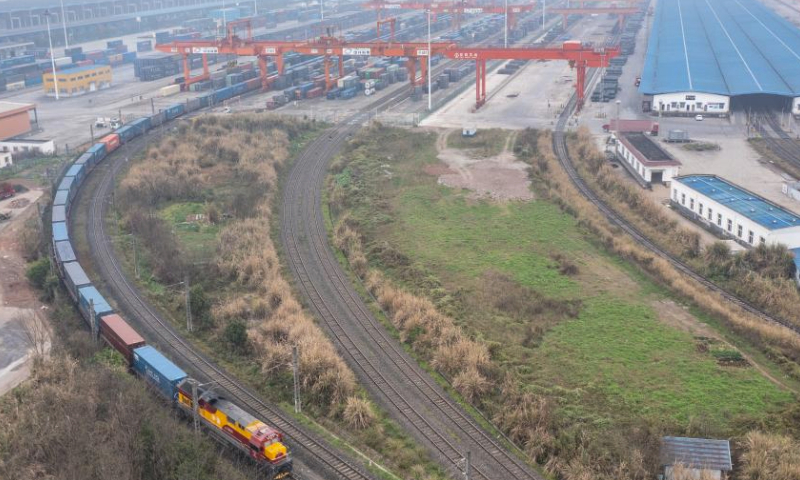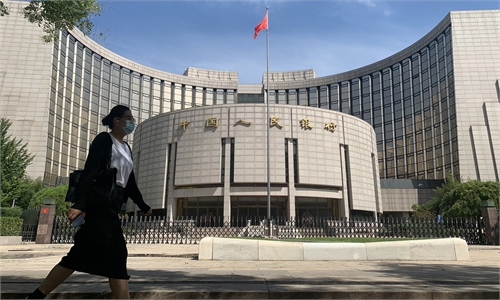

An aerial drone photo taken on March 7, 2024 shows a China-Europe freight train loaded with machinery, automobiles and auto parts pulling out of a railway station in Chongqing, southwest China. Benefiting from the increase of train trips and the launch of new freight train routes, including two direct rail routes to Spain and Türkiye, the city of Chongqing has seen increase in its export via China-Europe freight train service this year. Currently, the China-Europe freight train service has connected Chongqing with more than 100 cities and regions in Asia and Europe. Thousands of varieties of goods, including automobiles, auto parts, furniture, as well as medical equipment, have been transported via this service. Photo: Xinhua
While hyping China's local debt issue, foreign media outlets have been using the term "local debt mountain" to sensationalize risks. However, their reports are full of flawed logic and biased misconceptions. China has never neglected the potential risks associated with its debt size. There are many more countries in the world with debt sizes much larger than China's. Why does foreign media seldom express concerns over these economies' debt risks, but always focus on China?
There are historic reasons and objective laws behind the expanding debt size of modern countries. Looking back, rising government debts were often due to war or natural disasters. Following World War II, many economies' debt levels surged after a short period of reduction. Public investment and social security were the main reasons behind their surging debts. Before the 1970s, countries experienced rapid economic growth relying on demographic dividends, so expanding debt was not a problem for these countries.
As aging populations worsened and economic growth entered a period of stagnation in many countries, the financial markets' confidence in these economies gradually decreased, and the cost of government debt began to rise. By entering the 21st century, this situation eventually evolved into sovereign debt crises and regional (municipal debt) crises in some developed economies.
Unlike Western countries, since the founding of the People's Republic of China in 1949, China has always had a tradition of balancing its budget, borrowing as little as possible. Since the start of reform and opening-up, China's understanding of government debt has changed. It has been found that a reasonable amount of government debt can play a positive role in financing government funds and meeting public investment needs across economic cycles.
Adhering to the principle of spending within its means, China's government borrowing has provided greater flexibility and diversity of sources for public funds. Based on China's good credit, for decades, the World Bank, the International Monetary Fund, and the Asian Development Bank have always regarded China as an important cooperation partner.
Some major construction projects in China have also received strong support from international creditors. Investment returns after the completion of the projects have become the main source of funds for debt repayment. China's sovereign debt credit rating has always been at a relatively high level and has been recognized by most creditor countries and market creditors.
The central government has always maintained a cautious attitude toward local government borrowing, even when there is a strong demand for funds. In 1998, China faced a huge impact from the Asian financial crisis. Exports, investments, and consumption began to fluctuate. In order to stimulate the economy, the central government implemented an active fiscal policy.
The cautious and effective actions provide financial guarantees to deal with crises when they arise, and they become a new starting point for using government debt funds to support public investment construction. Currently, many highways, high-speed railways, and a large amount of municipal infrastructure across the country are all funded by government debt.
A growing number of developing countries, and even some developed countries, are starting to learn from China's experience in infrastructure investment. One important aspect is how to leverage the government's role in fund supply, especially the role of debt financing in infrastructure investment. In this regard, government debt plays a significant role in stabilizing economic operations and conducting strong and effective public investments.
Admittedly, public projects require large investments and have long cycles, which have increased the size of government debt. However, they have also created a massive amount of public assets, so there is no so-called systemic risk.
First, the construction and expansion of public projects rely on continuous funding. Government debt, as a relatively low-cost and stable source of financing, has always been a major source of funding for public project construction.
Second, government debt funding plays a significant role in public investment construction. The effective combination of government and market is a characteristic of the Chinese model. Many of China's cities' subways, water treatment plants, power plants, and other public projects, have the support of government debt funds, as well as injections of social funds. The increase in benefits from shared public assets enhances the efficiency of debt fund operation, ultimately benefiting the people.
The so-called systemic risk often manifests as widespread debt defaults and insolvency in economies, but this is fundamentally absent in the process of local government debt issuance in China.
The cash flow generated from large-scale public assets is important guarantees for debt repayment. The size of the local debt stock in China, is below the threshold set by the National People's Congress. In fact, governments at all levels in China have never had to shut down like in some countries due to debt ceilings. From any perspective, the idea of systemic risk does not exist in China.
On the contrary, the cost of debt financing for local governments in China continues to decrease, and the maturity period has significantly extended. Debt management has been standardized and daily supervision has been continuously strengthened. The pressure on the issuance and operation of local government debts in China has significantly decreased. The earlier irregular and unreasonable borrowing practices have quickly reduced.
The establishment of a comprehensive system for debt and budget management has been continuously promoted. This system not only provides institutional guarantees for local governments to borrow legally and compliantly, but also points out directions for preventing and resolving potential risks in local government debt.
China has established a positive incentive mechanism for local government debt management. China does not shy away from addressing hidden debts of local governments, but rather focuses on addressing the root causes of hidden debt. In resolving risks related to local government debt, China identifies key areas and addresses critical issues.
As the enhanced and standardized system for issuing and managing local government debt provides a strong guarantee for the positive impact of local government debt in China, there is no need to be concerned about the current size of local government debt in China, nor is there a risk of default looming.
The author is director of the Financial Research Office of the National Academy of Economic Strategy at Chinese Academy of Social Sciences. bizopinion@globaltimes.com.cn



